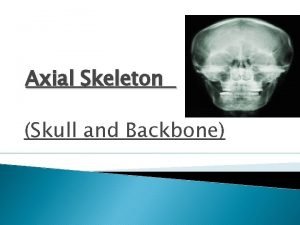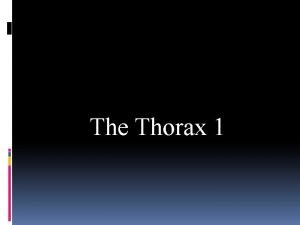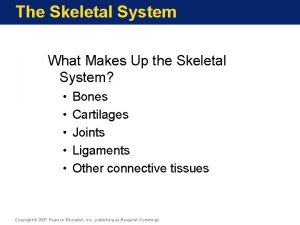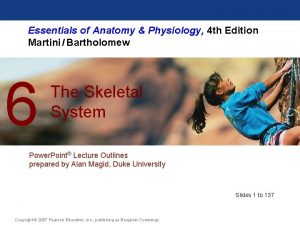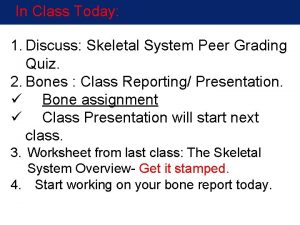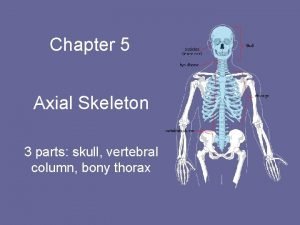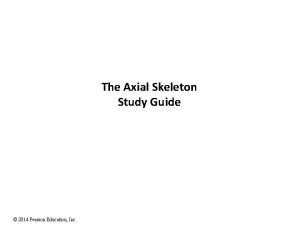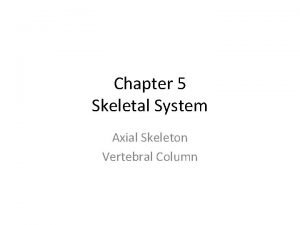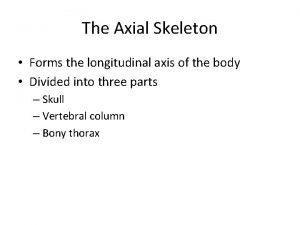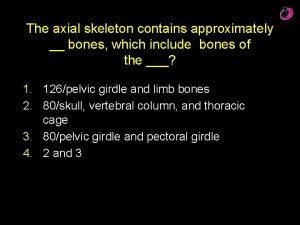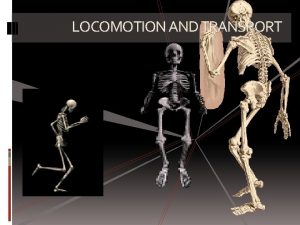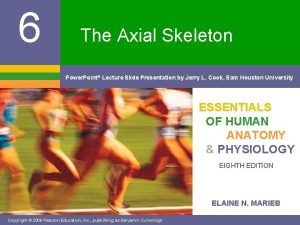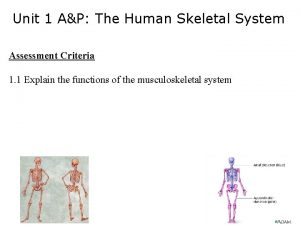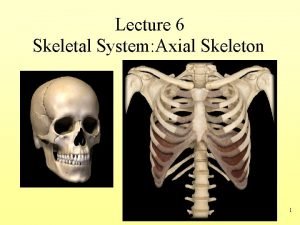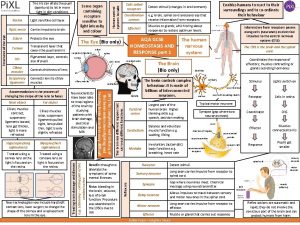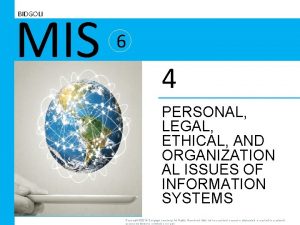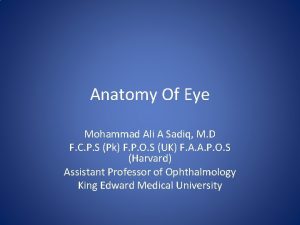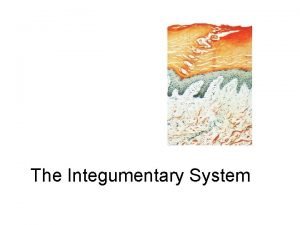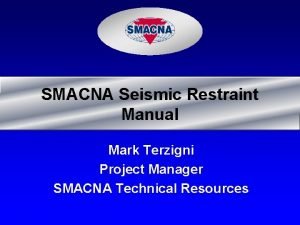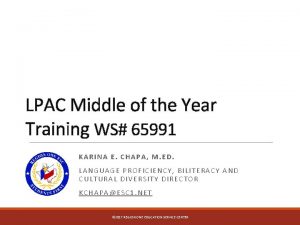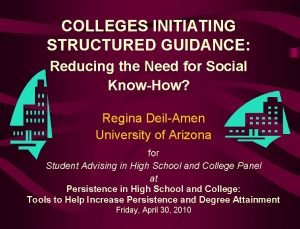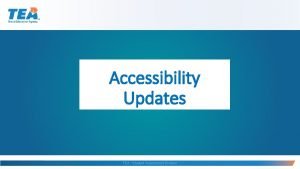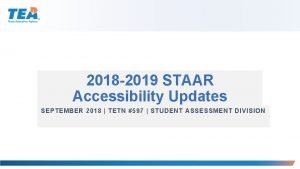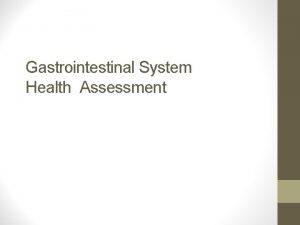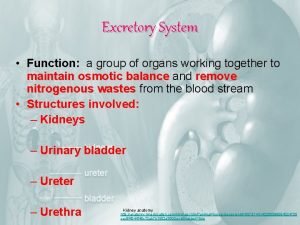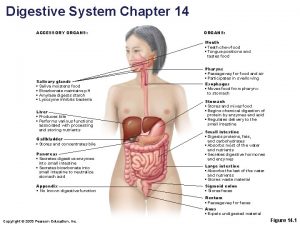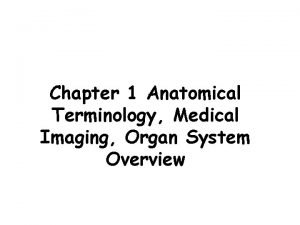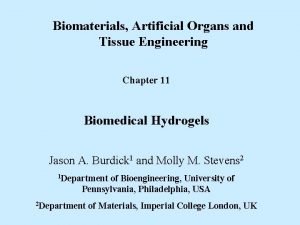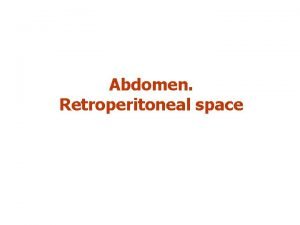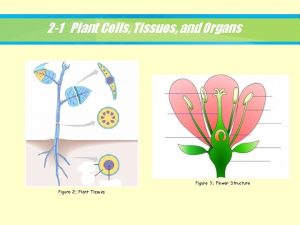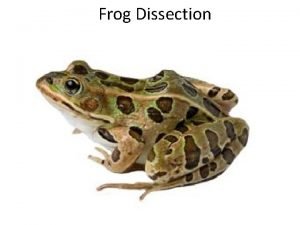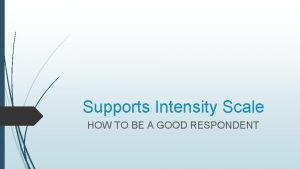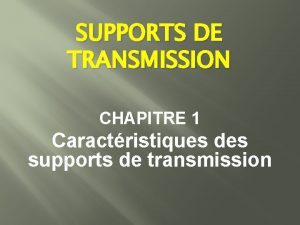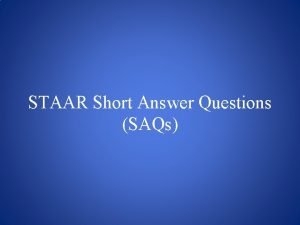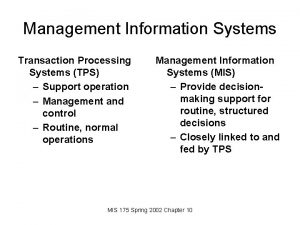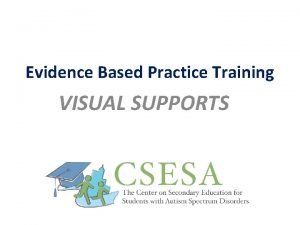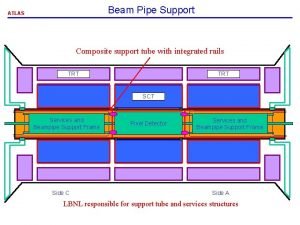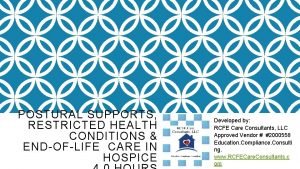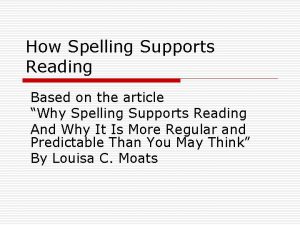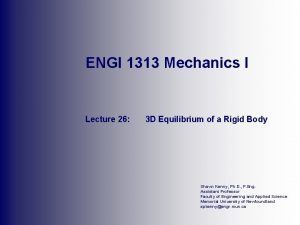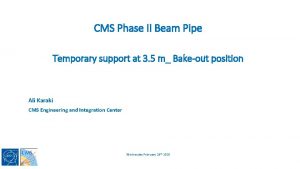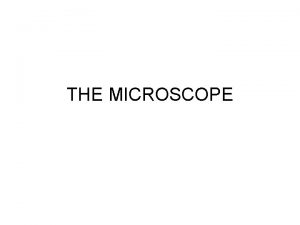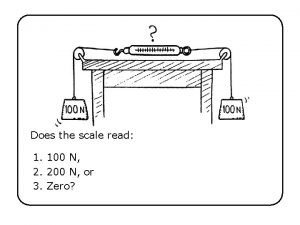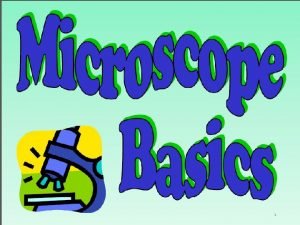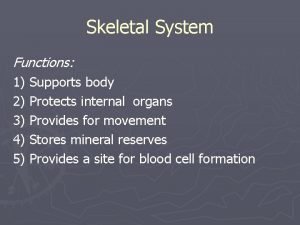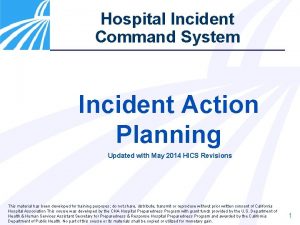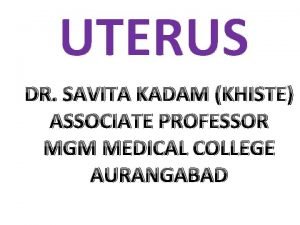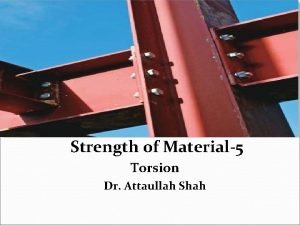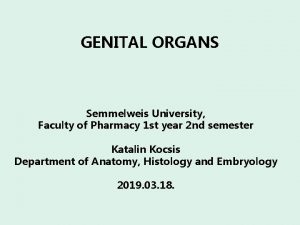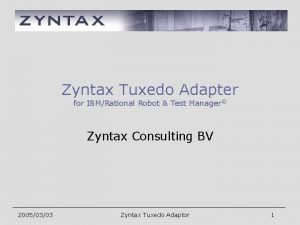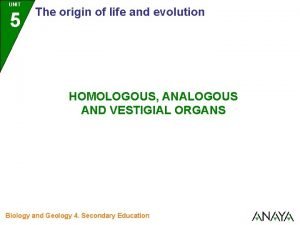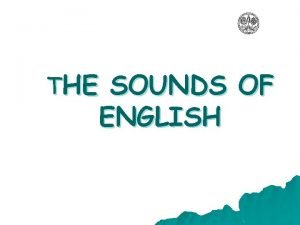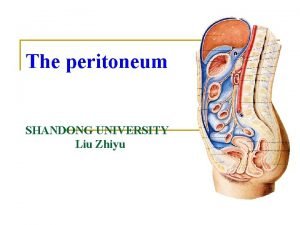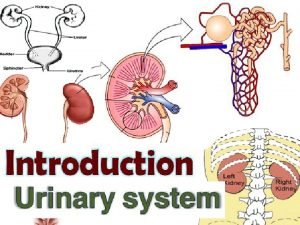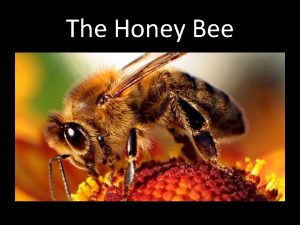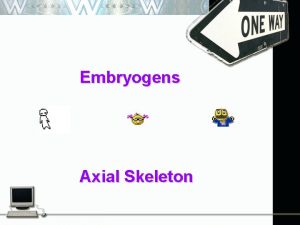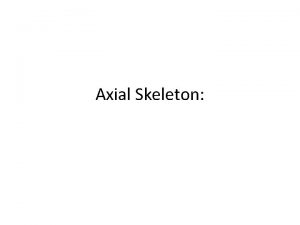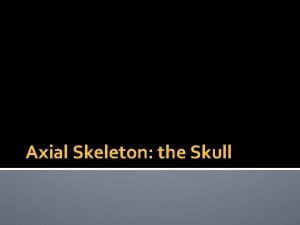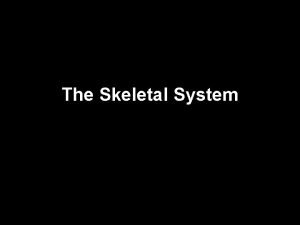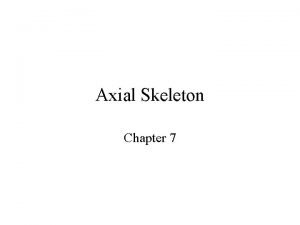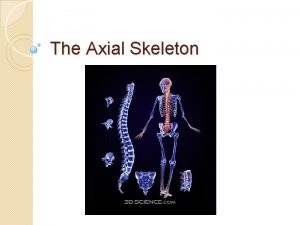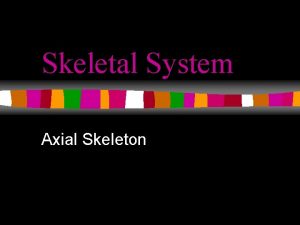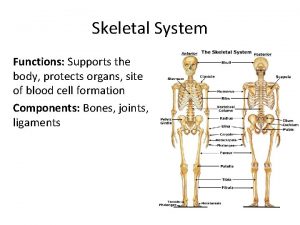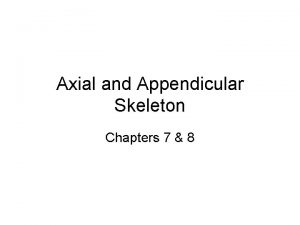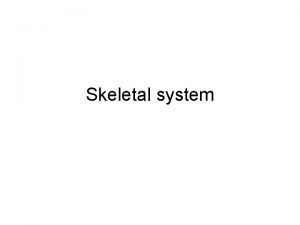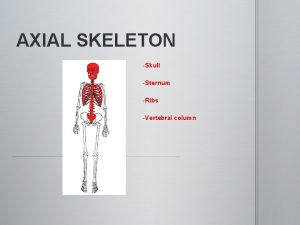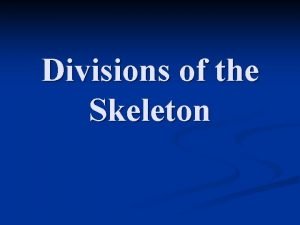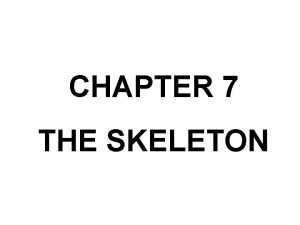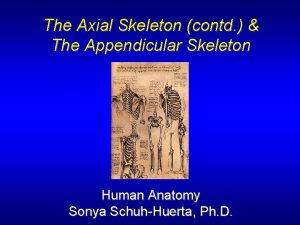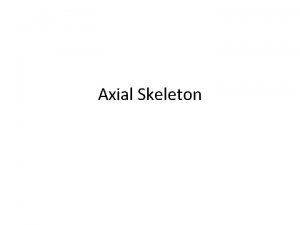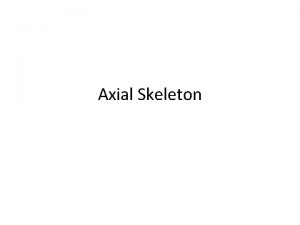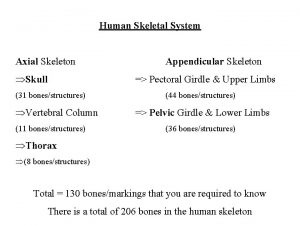Axial Skeleton Axial skeleton supports and protects organs





































































































- Slides: 101

Axial Skeleton Axial skeleton supports and protects organs of head, neck and trunk Axial skeleton: • Skull (cranium and facial bones) • Hyoid bone (anchors tongue and muscles associated with swallowing) • Vertebral column (vertebrae and disks) • Bony thorax (ribs and sternum)

Appendicular skeleton includes bones of limbs and bones that anchor them to the axial skeleton Appendicular skeleton: pectoral girdle (clavicle, scapula) upper limbs (arms) pelvic girdle (sacrum, coccyx) lower limbs (legs) Articulation- where joints meet, connect, and are formed.



The Axial Skeleton · Forms the longitudinal part of the body · Divided into three parts · Skull · Vertebral Column · Rib Cage Copyright © 2003 Pearson Education, Inc. publishing as Benjamin Cummings Slide

The Axial Skeleton Figure 5. 6 Copyright © 2003 Pearson Education, Inc. publishing as Benjamin Cummings Slide

The Skull • 8 sutured bones in cranium • Facial bones: 13 sutured bones 1 mandible Cranium: -encases brain -attachments for muscles -sinuses


Bones of the Skull Figure 5. 11 Copyright © 2003 Pearson Education, Inc. publishing as Benjamin Cummings

Allows for growth

Paranasal Sinuses · Hollow portions of bones surrounding the nasal cavity Figure 5. 10 Copyright © 2003 Pearson Education, Inc. publishing as Benjamin Cummings Slide


The Hyoid Bone · The only bone that does not articulate with another bone · Serves as a moveable base for the tongue, and other muscle attachments Figure 5. 12 Copyright © 2003 Pearson Education, Inc. publishing as Benjamin Cummings Slide 5. 26

Thyroglossal duct cyst (TGDC) excision is the most common midline congenital malformation of the neck. It results from incomplete involution of the thyroglossal duct, which connects the base of tongue to the thyroid

The Vertebral Column · Vertebrae separated by intervertebral discs made of cartilage · The spine has a normal S curvature · Each vertebrae is given a name according to its location Copyright © 2003 Pearson Education, Inc. publishing as Benjamin Cummings Figure 5. 14 Slide 5. 28


Thoracic cage -ribs -thoracic Vertebrae -sternum -costal cartilages • True ribs are directly attached to the sternum (first seven pairs) • Three false ribs are joined to the 7 th rib • Two pairs of floating ribs


Joints A joint, or articulation, is the place where two bones come together. • Fibrous- Immovable: connect bones, no movement. (skull and pelvis). • Cartilaginous- slightly movable, bones are attached by cartilage, a little movement (spine or ribs). • Synovial- freely movable, much more movement than cartilaginous joints. Cavities between bones are filled with synovial fluid. This fluid helps lubricate and protect the bones.

The Synovial Joint Figure 5. 28 Copyright © 2003 Pearson Education, Inc. publishing as Benjamin Cummings Slide 5. 51

Types of Synovial Joints Based on Shape Figure 5. 29 a–c Copyright © 2003 Pearson Education, Inc. publishing as Benjamin Cummings Slide

Types of Synovial Joints Based on Shape Figure 5. 29 d–f Copyright © 2003 Pearson Education, Inc. publishing as Benjamin Cummings Slide

Types of Joints Hinge- A hinge joint allows extension and retraction of an appendage. (Elbow, Knee)

Ball and Socket- A ball and socket joint allows for radial movement in almost any direction. They are found in the hips and shoulders. (Hip, Shoulder)

Gliding- In a gliding or plane joint bones slide past each other. Mid-carpal and midtarsal joints are gliding joints. (Hands, Feet)

Saddle- This type of joint occurs when the touching surfaces of two bones have both concave and convex regions with the shapes of the two bones complementing one other and allowing a wide range of movement. (Thumb)

Diseases and Conditions of the Skeletal System

Arthritis




Bursitis • Inflammation of the Bursa (fluid filled sac surrounding the joint). • A bursa can become inflamed from injury, infection (rare in the shoulder), or due to an underlying rheumatic condition. • Bursitis is typically identified by localized pain or swelling, tenderness, and pain with motion of the tissues in the affected area.



Tendonitis • Sometimes the tendons become inflamed for a variety of reasons, and the action of pulling the muscle becomes irritating. If the normal smooth gliding motion of your tendon is impaired, the tendon will become inflamed and movement will become painful. This is called tendonitis, and literally means inflammation of the tendon. • The most common cause of tendonitis is overuse.


S-shaped reverse sural flap for reconstruction of tissue defect on heel. (a) Wound of the recipient region. (b) Fasciocutaneous island of sural fl ap was elevated. (c) Postoperative appearance with S-like scar of the donor site.

Carpal Tunnel Syndrome • Any condition that causes swelling or a change in position of the tissue within the carpal tunnel can squeeze and irritate the median nerve. Irritation of the median nerve in this manner causes tingling and numbness of the thumb, index, and the middle fingers, a condition known as "carpal tunnel syndrome. "




Osteoporosis • Osteoporosis is a term that means "porous bones. " It is a skeletal disease affecting women and men. Osteoporosis is a condition in which bones have lost minerals especially calciumムmaking them weaker, more brittle, and susceptible to fractures (broken bones). Any bone in the body can be affected by osteoporosis, but the most common places where fractures occur are the back (spine), hips, and wrists.





Scoliosis • Scoliosis is an abnormal curvature of the spine. If your child has scoliosis, the view from behind may reveal one or more abnormal curves. Scoliosis runs in families, but doctors often don't know the cause. More girls than boys have severe scoliosis. Adult scoliosis may be a worsening of a condition that began in childhood, but wasn't diagnosed or treated. In other cases, scoliosis may result from a degenerative joint condition in the spine.






Kyphosis • With kyphosis, your spine may look normal or you may develop a hump. Kyphosis can occur as a result of developmental problems; degenerative diseases, such as arthritis of the spine; osteoporosis with compression fractures of the vertebrae; or trauma to the spine. It can affect children, adolescents and adults.



Lordosis • A normal spine, when viewed from behind appears straight. However, a spine affected by lordosis shows evidence of a curvature of the back bones (vertebrae) in the lower back area, giving the child a "swayback" appearance.



Tuberculosis of the Spine- Pott’s Disease • As a form of extrapulmonary tuberculosis that impacts the spine, Pott’s disease has an effect that is sometimes described as being a sort of arthritis for the vertebrae that make up the spinal column. More properly known as tuberculosis spondylitis, Pott’s disease is named after Dr. Percivall Pott, an eighteenth century surgeon who was considered an authority in issues related to the back and spine. Pott's disease is often experienced as a local phenomenon that begins in the thoracic section of the spinal column. Early signs of the presence of Pott’s disease generally begin with back pain that may seem to be due to simple muscle strain. However, in short order, the symptoms will begin to multiply.




Rickets • Rickets is the softening and weakening of bones in children, usually because of an extreme and prolonged vitamin D deficiency. • Some skeletal deformities caused by rickets may need corrective surgery.




Scurvy • The human body lacks the ability to synthesize and make vitamin C and therefore depends on exogenous dietary sources to meet vitamin C needs. Consumption of fruits and vegetables or diets fortified with vitamin C are essential to avoid ascorbic acid deficiency. Even though scurvy is uncommon, it still occurs and can affect adults and children who have chronic dietary vitamin C deficiency.



Gout • Gout is a disease that results from an overload of uric acid in the body. This overload of uric acid leads to the formation of tiny crystals of urate that deposit in tissues of the body, especially the joints. When crystals form in the joints it causes recurring attacks of joint inflammation (arthritis). Chronic gout can also lead to deposits of hard lumps of uric acid in and around the joints and may cause joint destruction, decreased kidney function, and kidney stones.




Acromegaly • Acromegaly is a serious condition that occurs when the body produces too much of the hormones that control growth. ・The hormone most often affected is called growth hormone, or GH. It is produced by the pituitary gland, a tiny organ at the base of the brain. ・・ Growth hormone promotes growth of bone, cartilage, muscle, organs, and other tissues. ・・When there is too much growth hormone in the body, these tissues grow larger than normal. This excessive growth can cause serious disease and even premature death.





Poliomyelitis • Poliomyelitis (polio) is a highly infectious disease caused by a virus. It invades the nervous system, and can cause total paralysis in a matter of hours. It can strike at any age, but affects mainly children under three (over 50% of all cases). The virus enters the body through the mouth and multiplies in the intestine. Initial symptoms are fever, fatigue, headache, vomiting, stiffness in the neck and pain in the limbs. One in 200 infections leads to irreversible paralysis (usually in the legs). Amongst those paralysed, 5%-10% die when their breathing muscles become immobilized. Although polio paralysis is the most visible sign of polio infection, fewer than 1% of polio infections ever result in paralysis. Poliovirus can spread widely before cases of paralysis are seen. As most people infected with poliovirus have no signs of illness, they are never aware they have been infected. After initial infection with poliovirus, the virus is shed intermittently in faeces (excrement) for several weeks. During that time, polio can spread rapidly through the community.



Spina Bifida • Spina bifida is a birth defect that involves the incomplete development of the spinal cord or its coverings. The term spina bifida comes from Latin and literally means "split" or "open" spine. Spina bifida occurs at the end of the first month of pregnancy when the two sides of theハembryo's spine fail to join together, leaving an open area. In some cases, the spinal cord or other membranes may push through this opening in the back. The condition usually isハdetected before a baby is born and treated right away.




Talipes Equinovarus“Clubfoot” • Clubfoot is a deformity of the whole foot that is present at birth. There are several types of clubfoot that are jointly known as 'talipes', as the deformity is mostly in the talus (a bone in the ankle). The most common of the talipes is what is known as "talipes equino varus" - it is so common that the word clubfoot is commonly used to refer to this. In talipes equino varus, the child is born with the foot pointing down and twisted inwards at the ankle.




Sarcoma • Osteosarcoma-The most common type of bone cancer. It arises in bone and is most commonly found in children and adolescents but a rare form occurs in adults, particularly in patients who have been cured of other cancers with radiation therapy.





Myeloma • Multiple myeloma is a cancer in which abnormal cells collect in the bone marrow and form tumors. Sometimes these abnormal cells (called myeloma cells) collect in only one bone and form a single tumor known as a plasmacytoma. However, in most cases, the myeloma cells collect in many bones, forming several tumors and causing other problems. When this happens, the disease is called multiple myeloma.



Leukemia • Leukemia is cancer of the blood cells. It starts in the bone marrow, the soft tissue inside most bones. Bone marrow is where blood cells are made. When you are healthy, your bone marrow makes: ・White blood cells, which help your body fight infection. ・Red blood cells, which carry oxygen to all parts of your body. ・ Platelets, which help your blood clot. When you have leukemia, the bone marrow starts to make a lot of abnormal white blood cells, called leukemia cells. They don't do the work of normal white blood cells, they grow faster than normal cells, and they don't stop growing when they should.



Bone Marrow Biopsy
 Difference between axial and appendicular skeleton
Difference between axial and appendicular skeleton Axial skeleton vs appendicular
Axial skeleton vs appendicular Axial vs appendicular
Axial vs appendicular Differentiate between axial and appendicular skeleton
Differentiate between axial and appendicular skeleton Figure 6-4 the skeleton axial and appendicular divisions
Figure 6-4 the skeleton axial and appendicular divisions Figure 6-4 the skeleton axial and appendicular divisions
Figure 6-4 the skeleton axial and appendicular divisions Figure 6-4 the skeleton axial and appendicular divisions
Figure 6-4 the skeleton axial and appendicular divisions Figure 6-4 the skeleton axial and appendicular divisions
Figure 6-4 the skeleton axial and appendicular divisions Chapter 5 the skeletal system axial skeleton skull
Chapter 5 the skeletal system axial skeleton skull Mandibular foramen
Mandibular foramen Axial skeleton chapter 5 the skeletal system
Axial skeleton chapter 5 the skeletal system 7 12 5 spine
7 12 5 spine Chapter 5 the skeletal system figure 5-13
Chapter 5 the skeletal system figure 5-13 The axial skeleton contains
The axial skeleton contains 5 function of skeletal system
5 function of skeletal system Axial skeleton concept map
Axial skeleton concept map Lacrimal bones
Lacrimal bones C1 vertebrae name
C1 vertebrae name Sadpam
Sadpam Axial skeleton
Axial skeleton Transparent eye layer that protects iris and pupil
Transparent eye layer that protects iris and pupil Mis bidgoli
Mis bidgoli A thin fold of skin that covers and protects the human eye
A thin fold of skin that covers and protects the human eye What part of the plant carries and protects the seed
What part of the plant carries and protects the seed What protects cushions and insulates the skin
What protects cushions and insulates the skin The atmosphere protects earth from
The atmosphere protects earth from The atmosphere protects earth from
The atmosphere protects earth from Factors affecting stroke volume
Factors affecting stroke volume What type of footwear protects your entire foot
What type of footwear protects your entire foot The ozone layer protects us from
The ozone layer protects us from Epithelium which protects inner part of the body is
Epithelium which protects inner part of the body is Smacna seismic restraint manual
Smacna seismic restraint manual Ricas grade 3-8 math
Ricas grade 3-8 math Staar content and language supports
Staar content and language supports Structured guidance and supports
Structured guidance and supports Tea content and language supports
Tea content and language supports What is content and language supports
What is content and language supports Growth mindset and metacognition
Growth mindset and metacognition Pinecrest supports and services center
Pinecrest supports and services center Positive behavioral interventions and supports
Positive behavioral interventions and supports Positive behavioral interventions and supports
Positive behavioral interventions and supports Primary and secondary retroperitoneal organs
Primary and secondary retroperitoneal organs 4 quadrants of the abdomen
4 quadrants of the abdomen What is the function of the excretory system
What is the function of the excretory system Major and accessory organs of the digestive system
Major and accessory organs of the digestive system Right arm medical term
Right arm medical term Biomaterials artificial organs and tissue engineering
Biomaterials artificial organs and tissue engineering Digestive accessory organs
Digestive accessory organs Primary and secondary retroperitoneal organs
Primary and secondary retroperitoneal organs Lymphatic system and urinary system
Lymphatic system and urinary system Ground tissue
Ground tissue Largest lymphoid organ
Largest lymphoid organ Plant tissue and organs
Plant tissue and organs Colonchyma
Colonchyma Frog organs and functions
Frog organs and functions Supports intensity scale rating key
Supports intensity scale rating key Les supports de transmission
Les supports de transmission This excerpt supports the idea that rainsford has
This excerpt supports the idea that rainsford has Snmp model in computer networks
Snmp model in computer networks Tps information system
Tps information system 80386 flag register
80386 flag register Visual supports evidence based practice
Visual supports evidence based practice Composite pipe supports
Composite pipe supports Truman supports civil rights
Truman supports civil rights Opinionated paragraph examples
Opinionated paragraph examples Postural supports definition
Postural supports definition The period of activism was romantic and revolutionary
The period of activism was romantic and revolutionary How spelling supports reading
How spelling supports reading The pipe assembly supports the vertical loads shown
The pipe assembly supports the vertical loads shown Raceways electrical
Raceways electrical Temporary pipe supports
Temporary pipe supports What are the adm 5 main focus areas in accenture
What are the adm 5 main focus areas in accenture When did renaissance start
When did renaissance start Body tube microscope
Body tube microscope Which of the following is not true about pl/sql cursors?
Which of the following is not true about pl/sql cursors? Does the scale read 100 n
Does the scale read 100 n What is the author's purpose in this paragraph
What is the author's purpose in this paragraph Foundational community supports
Foundational community supports Microscope body tube function
Microscope body tube function Christianity vs paganism chart
Christianity vs paganism chart What system supports the body
What system supports the body Incident action planning guide
Incident action planning guide Optical fiber waveguide
Optical fiber waveguide Dsp computational building blocks
Dsp computational building blocks Interconnected systems framework
Interconnected systems framework Dextrorotation of uterus
Dextrorotation of uterus Supports the body
Supports the body An aluminum shaft with a constant diameter of 50mm
An aluminum shaft with a constant diameter of 50mm The is the fine hair-like stalk that supports the anther.
The is the fine hair-like stalk that supports the anther. School leaver employment support 3
School leaver employment support 3 Multimedia dbms
Multimedia dbms Anteflexion of uterus
Anteflexion of uterus Rational robot ibm rational supports which os
Rational robot ibm rational supports which os The first linux kernel which supports the smp hardware
The first linux kernel which supports the smp hardware Organs of wto
Organs of wto Homologous and analogous
Homologous and analogous English vowel sounds
English vowel sounds Phrenicosplenic
Phrenicosplenic Ligament of the stomach
Ligament of the stomach Greater sac lesser sac
Greater sac lesser sac Kidney is a retroperitoneal organ
Kidney is a retroperitoneal organ Pollen basket
Pollen basket

